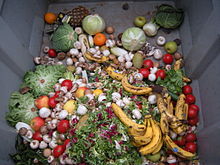Biodegradable waste
| Part of a series on |
| Pollution |
|---|
 |
Biodegradable waste includes any
In
Biodegradable waste when not handled properly can have an outsized impact on climate change, especially through
Sources
Biodegradable waste can be found in
In the UK, 7.4 million tonnes of biodegradable waste was sent to landfill in 2018 having reduced from 7.8 million tonnes in 2017.[5]
Collection and processing
In many parts of the developed world, biodegradable waste is separated from the rest of the waste stream, either by separate curb-side collection or by waste sorting after collection. At the point of collection such waste is often referred to as green waste.[6] Removing such waste from the rest of the waste stream substantially reduces waste volumes for disposal and also allows biodegradable waste to be composted.
Biodegradable waste can be used for composting or a resource for heat, electricity and fuel by means of
Valorization
Crop residue
Food waste
One of the more fruitful fields of work is food waste—when deposited in landfills, food waste produces
Human excreta

Reuse of human excreta is the safe, beneficial use of treated human excreta after applying suitable treatment steps and risk management approaches that are customized for the intended reuse application. Beneficial uses of the treated excreta may focus on using the plant-available nutrients (mainly nitrogen, phosphorus and potassium) that are contained in the treated excreta. They may also make use of the organic matter and energy contained in the excreta. To a lesser extent, reuse of the excreta's water content might also take place, although this is better known as water reclamation from municipal wastewater. The intended reuse applications for the nutrient content may include: soil conditioner or fertilizer in agriculture or horticultural activities. Other reuse applications, which focus more on the organic matter content of the excreta, include use as a fuel source or as an energy source in the form of biogas.
There is a large and growing number of treatment options to make excreta safe and manageable for the intended reuse option.[14] Options include urine diversion and dehydration of feces (urine-diverting dry toilets), composting (composting toilets or external composting processes), sewage sludge treatment technologies and a range of fecal sludge treatment processes. They all achieve various degrees of pathogen removal and reduction in water content for easier handling. Pathogens of concern are enteric bacteria, virus, protozoa, and helminth eggs in feces.[15] As the helminth eggs are the pathogens that are the most difficult to destroy with treatment processes, they are commonly used as an indicator organism in reuse schemes. Other health risks and environmental pollution aspects that need to be considered include spreading micropollutants, pharmaceutical residues and nitrate in the environment which could cause groundwater pollution and thus potentially affect drinking water quality.Climate change impacts
Landfill gas

Landfill gases have an influence on
Food waste


Food loss and waste is a major part of the
See also
References
- ^ "Why can't I put my leftover gyproc/drywall in the garbage?". Recycling Council of British Columbia. 19 September 2008.
- ^ "Fact Sheet: Methane and Hydrogen Sulfide Gases at C&DD Landfills" (PDF). Environmental Protection Agency. State of Ohio, U.S.
- ^ "Organics -Green Bin". Christchurch City Council. Retrieved 19 March 2016.
- ^ CSL London Olympics Waste Review. cslondon.org
- ^ "UK Statistics on Waste" (PDF). March 2019. Retrieved 7 November 2019.
- ^ "Organics - Green Bin". Christchurch City Council. Retrieved 12 March 2016.
- National Non-Food Crops Centre. NNFCC report on Evaluation of Opportunities for Converting Indigenous UK Wastes to Fuels and Energy Archived 20 July 2011 at the Wayback Machine. nnfcc.co.uk
- ^ Recycling chain Archived 2012-03-23 at the Wayback Machine. kompogas-utzenstorf.ch
- ^ AIKAN website. aikantechnology.com
- ^ "Gesundheit, Kraft und Energie für 2002". zuonline.ch. 3 January 2002. Archived from the original on 2 September 2002.
- ^ ISSN 2050-0505.
- ^ S2CID 58620752.
- PMID 34441479.
- ISBN 978-3-906484-57-0.
- ISSN 1064-3389.
- ^ "Methane Emissions". Environmental Protection Agency. 23 December 2015. Retrieved 13 June 2016.
- ^ Greenfield, Robin (2014-10-06). "The Food Waste Fiasco: You Have to See it to Believe it!". www.robingreenfield.org.
- OCLC 1126211917.
- ^ "UN Calls for Action to End Food Waste Culture". Daily News Brief. 2021-10-04. Archived from the original on 2021-10-04. Retrieved 2021-10-04.
- ^ ISBN 9789280738513. Archivedfrom the original on 2022-02-01. Retrieved 2022-02-01.
- ^ "FAO - News Article: Food wastage: Key facts and figures". www.fao.org. Archived from the original on 2021-06-07. Retrieved 2021-06-07.
- ^ "A third of food is wasted, making it third-biggest carbon emitter, U.N. says". Reuters. 2013-09-11. Archived from the original on 2021-06-07. Retrieved 2021-06-07.
- ^ "Brief on food waste in the European Union". European Commission. 2020-08-25. Archived from the original on 2022-11-15. Retrieved 2022-11-15.
- ^ "Food Recovery Hierarchy". www.epa.gov. 2015-08-12. Archived from the original on 2019-05-23. Retrieved 2022-05-15.
- ^ United Nations (2017) Resolution adopted by the General Assembly on 6 July 2017, Work of the Statistical Commission pertaining to the 2030 Agenda for Sustainable Development (A/RES/71/313 Archived 2020-10-23 at the Wayback Machine)
- ^ "Reduced Food Waste". Project Drawdown. 2020-02-12. Archived from the original on 2020-09-24. Retrieved 2020-09-19.
- ^ "COP15: Nations Adopt Four Goals, 23 Targets for 2030 in Landmark UN Biodiversity Agreement". Convention on Biological Diversity. United Nations. Archived from the original on 2022-12-20. Retrieved 9 January 2023.

